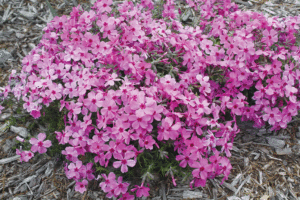
The native Phlox subulata or Moss Phlox comes in so many pastel spring colors — blues, pinks, blush and pure white. It is an evergreen groundcover that needs full sun and excellent drainage which is perfect for the Eastern Shore’s sandy soils. (Photo by Ginny Rosenkranz)
April is when spring really starts to bloom!
Spring, to me, is always a treasure hunt — walking around the gardens and seeing what is up and blooming as well.
A few of the plants that bloom include Phlox subulata (Moss Phlox), Aurinia saxatilis (Basket of Gold), Bergenia cordifolia (Heart Leaf Bergengia), Iberis semperviens (Candytuft), Iris cristata (Crested Iris).
Some plants like the Moss Phlox and Crested Iris are natives to North America while the Basket of Gold, Heart leaf Bergengia and Candytuft arrived from other continents.
I always try to include the botanical names of the plants I talk about so if anyone falls in love with them, they will be easy to find.
Common names are fun and picturesque, but often they reflect a region or a portion of a state, or just because someone thought it sounded good, but that doesn’t make it easy to find in a garden center.
The native Phlox subulata or Moss Phlox comes in so many pastel spring colors — blues, pinks, blush and pure white.
The plant is an evergreen groundcover that needs full sun and excellent drainage which is perfect for our sandy soils on the Eastern Shore.
I love the fact that it starts to bloom sporadically in February and March, but comes into its full glory in April.
Many perennials bloom only for two weeks, but the Moss Phlox can bloom for almost eight weeks, especially if the weather stays cool.
Aurinia saxitilis, also known as Basket of Gold, is not a native, but it still loves the same growing conditions of full sun and sandy well drained soils.
The foliage is gray green and the flowers a shimmering golden yellow that brightens up any sunny garden in the spring.
Basket of Gold does bloom for two to four weeks, so it is worth planting for springtime color.
Bergenia cordifolia or Heart Leaf Bergenia has thick shiny dark green evergreen leaves that prefer to grow in the afternoon shade.
In April the flower stalks rise up from the center of the rosette of leaves and looks like a perfect bouquet of tiny red, pink or white flowers that last for at least two weeks.
Bergenia coridfolia has another very colorful common name of “Pig Squeak.”
If you rub your fingers and thumb against the thick green leaves, it gives of a soft squeaking sound which will entertain children from 1 year old to 100 years old.
Iris cristata or Crested Iris is a native Iris that grows best in the cool afternoon shade.
The four-inch high light green leaves are evergreen all winter and the plant grows quickly from shallow rhizomes (a modified root) to spread in the woodland garden.
The flowers are only six inches tall and are pale blue with the Iris standards that are upright, short and narrow, and the blue falls are topped with a deep yellow crest.
The flowers only last two weeks so plant them where they can be viewed, possibly planted close to a woodland path.
Iberis sempervirens, or Candytuft, has dark green evergreen leaves that makes the plant perfect for the edging or front of a garden or as a ground cover in full sun or light dappled shade.
The pure white flowers look a bit like a lacy umbrellas that garden fairies use to keep the sun off of their hair when they go visiting.
When in bloom, the pure white lacy flowers cover the dark green foliage for what can be as many as 10 weeks.
All of the spring flowers will survive the occasional cold spell and even some snow that tries to lengthen winter — and although the flowers may be a bit brown around the edges, they will continue to bloom through the cold to bring the promise of spring to the garden.
(Editor’s Note: Ginny Rosenkranz is a commercial horticulture specialist with the University of Maryland Extension.)



